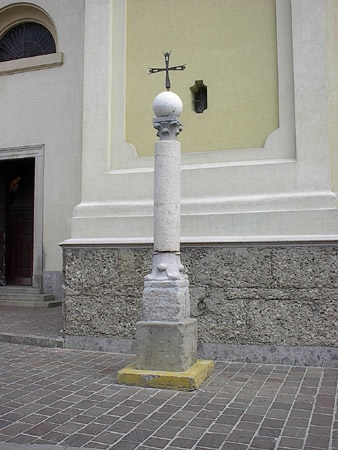Quando la peste infuriava sulla Brianza
(Il Giorno, 8 march 2020)

They rise suddenly, near churches or crossroads. High, solemn, recognizable even at a distance by elements such as spheres or capitals. And, of course, with a cross over them. They are votive columns or plague crosses, on which can still be read a few historiated sentences in Latin. They had them built – at least many of them – after 1576, following the great plague that spread bereavement in northern Italy. And even in Brianza. Several sources talk about it, from the biographers of San Carlo Borromeo, the Archbishop of Milan who fought as hard as he could against a drama of immense proportions, to the historian Ignazio Cantù. Alessandro Manzoni also mentions the plague in The Betrothed.
The plague of 1576 is said to have been brought by some pilgrim going to the Jubilee of Rome, by soldiers of fortune always on the move in those years or even by infected goods from Hungary. Passing from Trento, Verona and Mantua, the plague had struck Trezzo, Vaprio d’Adda and Vimercate first, until it exploded in all its tragedy in July 1576. Ignazio Cantù tells that a certain Moretto, a wool comber that had contracted the disease in Milan “in the village of greengrocers where the plague raged, and spreading it immediately to Seregno, his homeland, from which it spread to the neighboring lands”. In Seregno, the infection was initially kept hidden. “The inhabitants of Seregno, predicting the damage that would return to their trade, when the rumor spread that they were touched by evil”, although they died dozens every day, “for a long time kept it hidden”. Until finally the rulers of the time had to take drastic measures. “They had to find out, close many houses in the village and build huts to shelter the sick”.
The news came immediately to Milan. Even the magistrates of Milan, however, who were already struggling with the infection in their city, did not do very much. Indeed, it seems that several of them fled. Meanwhile the plague was raging in Brianza. There are documents that tell how a law had forbidden the inhabitants of Lentate, Seregno, Lurago, Vedano, Meda and Varedo to leave their countries, and ordered that signs be planted around these lands to delimit the boundaries not to be crossed. All useless measures, though. At least a hundred inhabitants were involved, including those of Caponago, Carate, Cantù, Canonica del Lambro, Annone, Garlate, Olginate, Barzanò.
In this cataclysm emerges the figure of Carlo Borromeo, Archbishop of Milan, he who “exercised his fraternal charity, went where the others fled and entered hospitals for plague victims in order to administer the sacraments”. Although he knew he could contract the disease, he went to hospitals, homes, infected tents throughout the Diocese to administer the Eucharist and the anointing. The alms he collected were left in a jar full of vinegar, while a servant accompanied him with a stick that served to keep the sick at a distance so that they did not touch him. He left all his property at the Ospedale Maggiore in Milan. The Archbishop encouraged other priests to follow his example, even if he realized how the contagion made victims especially among the rescuers. He tried to send willing people from Milan who could go to Brianza, even if not always successfully.
The archbishop also organized “continuous prayers”. Seven times during the day and seven during the night, the bells invited the people to pray and everyone, wherever they were, had to recite litanies, psalms and invoke divine mercy. Carlo Borromeo was also spurred by hygienic reasons. Prohibiting the gathering of people inside closed spaces it was necessary to organize masses in “field churches”. And once the epidemic was over and the altars dismantled, it was decided to erect votive columns in their place, as an act of devotion and gratitude from the survivors. In Brugherio they are still visible in Piazza Roma, beside the church of San Bartolomeo; on viale Lombardia, not far from the old cemetery; at the crossroads of Torazza and in San Damiano. One is also located in Piazza Duomo, in Monza, which has always been known as “La Crocetta”.
There is also a sacred procession in memory of the pestilence, the procession of the Holy Nail (“Sacro Chiodo”). In 1576 San Carlo Borromeo carried through the streets of Milan the relic of the nail with which Jesus had been crucified. In memory of the event, the Iron Crown of Lombardy, kept in the Cathedral of Monza (which tradition holds to be made of iron beaten out of a nail from the cross upon which Jesus was crucified) is carried in procession through the main streets of the city.








